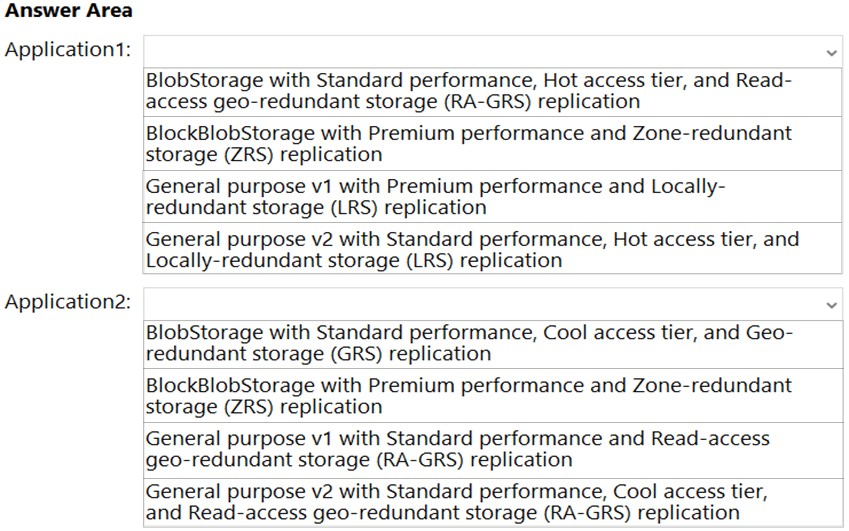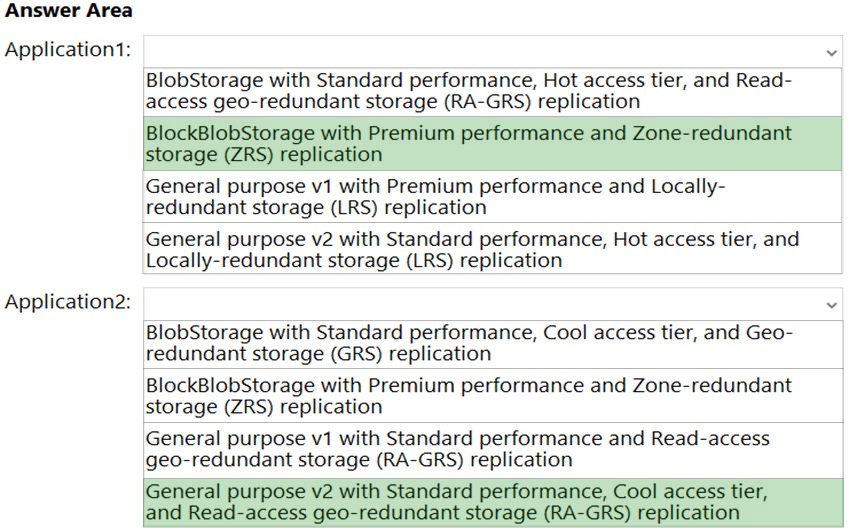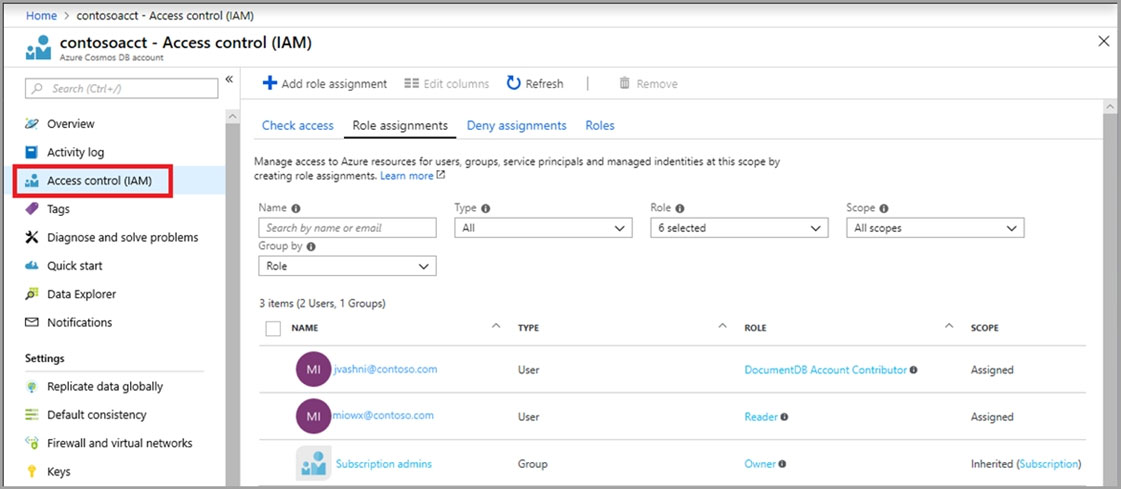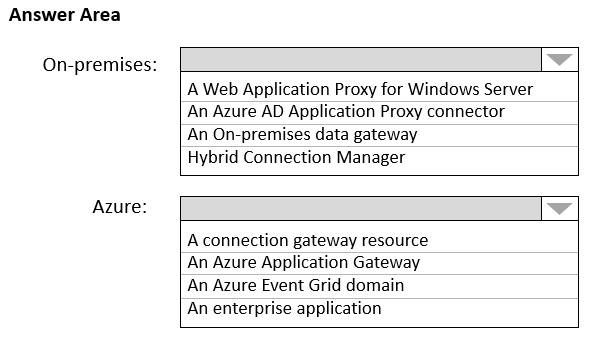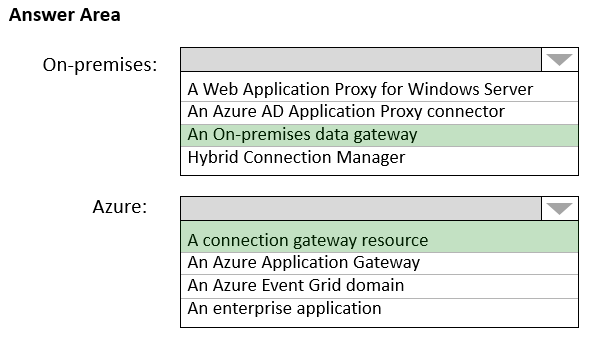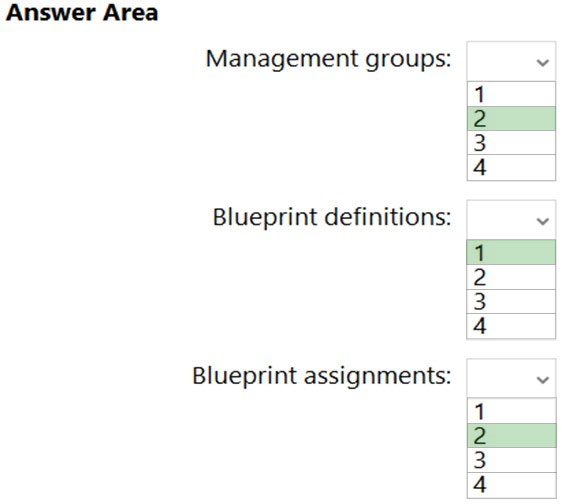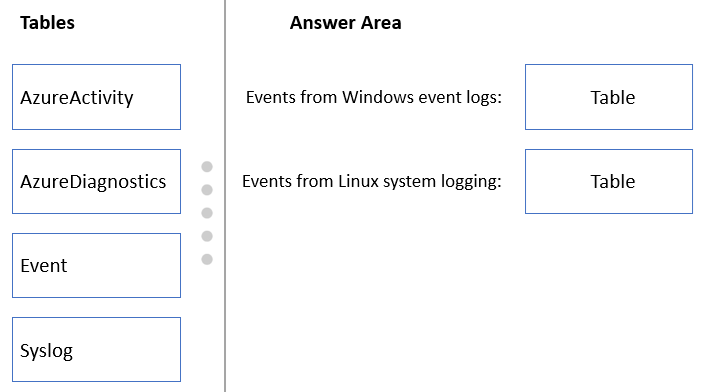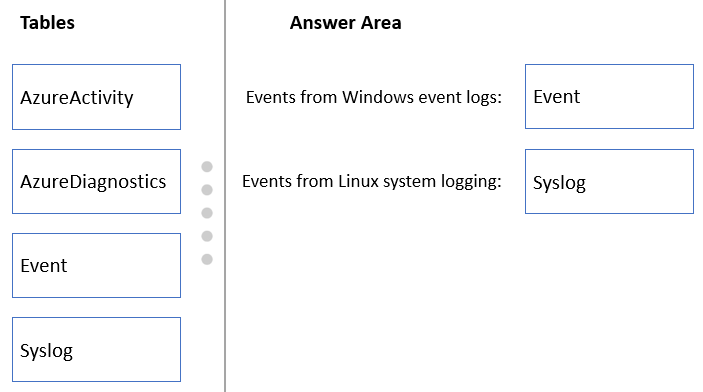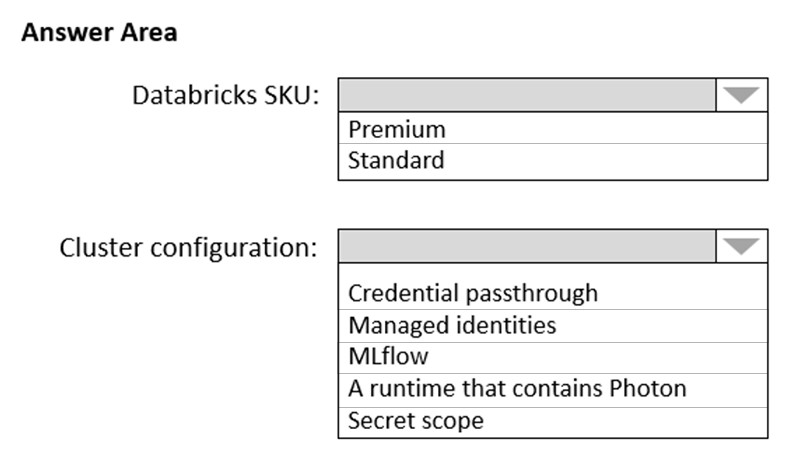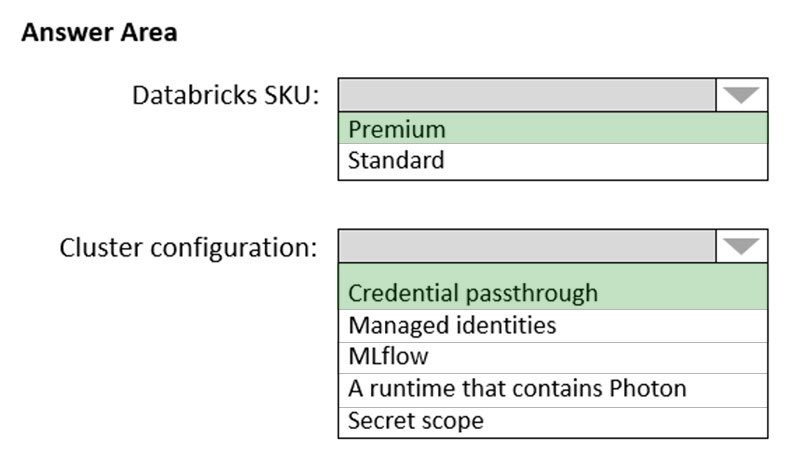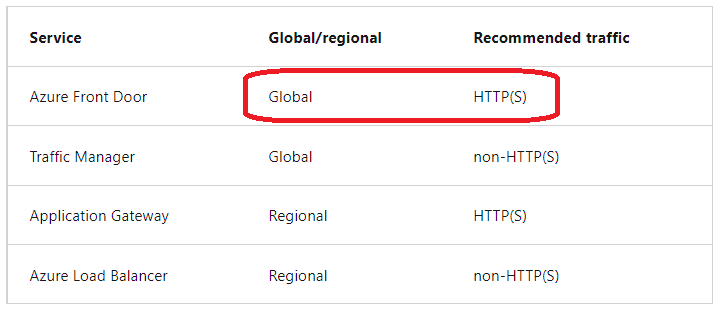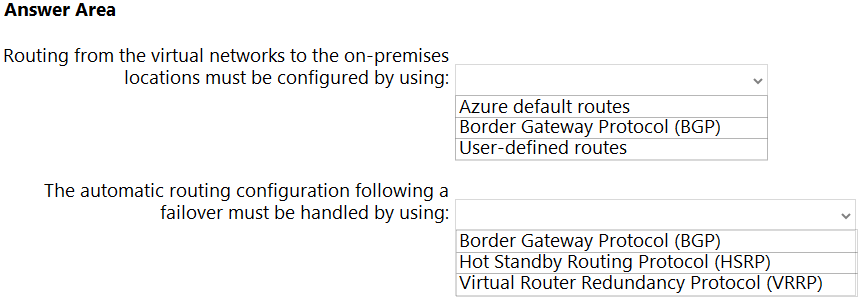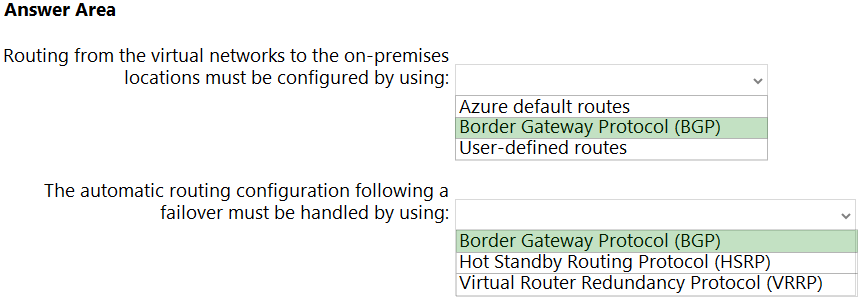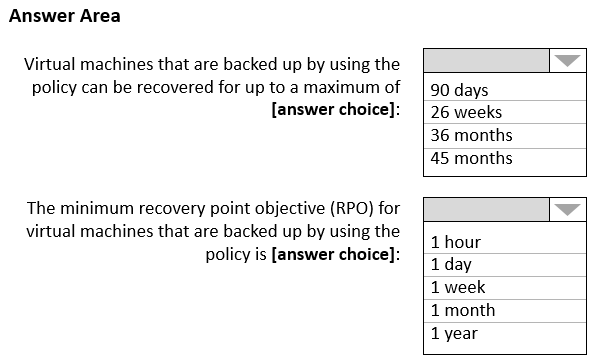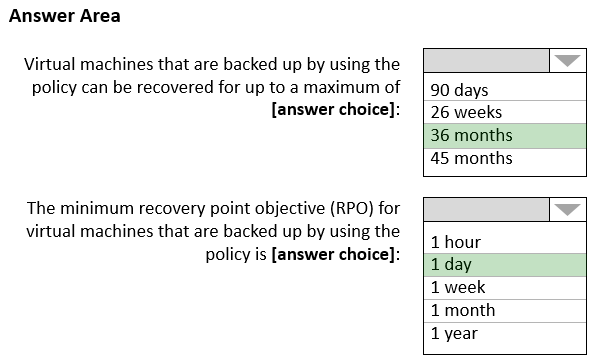AZ-305 Practice Test Free – 50 Real Exam Questions to Boost Your Confidence
Preparing for the AZ-305 exam? Start with our AZ-305 Practice Test Free – a set of 50 high-quality, exam-style questions crafted to help you assess your knowledge and improve your chances of passing on the first try.
Taking a AZ-305 practice test free is one of the smartest ways to:
- Get familiar with the real exam format and question types
- Evaluate your strengths and spot knowledge gaps
- Gain the confidence you need to succeed on exam day
Below, you will find 50 free AZ-305 practice questions to help you prepare for the exam. These questions are designed to reflect the real exam structure and difficulty level. You can click on each Question to explore the details.
HOTSPOT - You need to recommend an Azure Storage account configuration for two applications named Application1 and Application2. The configuration must meet the following requirements: ✑ Storage for Application1 must provide the highest possible transaction rates and the lowest possible latency. ✑ Storage for Application2 must provide the lowest possible storage costs per GB. ✑ Storage for both applications must be available in an event of datacenter failure. ✑ Storage for both applications must be optimized for uploads and downloads. What should you recommend? To answer, select the appropriate options in the answer area. NOTE: Each correct selection is worth one point. Hot Area:
You have an Azure Active Directory (Azure AD) tenant. You plan to deploy Azure Cosmos DB databases that will use the SQL API. You need to recommend a solution to provide specific Azure AD user accounts with read access to the Cosmos DB databases. What should you include in the recommendation?
A. shared access signatures (SAS) and Conditional Access policies
B. certificates and Azure Key Vault
C. master keys and Azure Information Protection policies
D. a resource token and an Access control (IAM) role assignment
You have an Azure subscription that contains a Basic Azure virtual WAN named VirtualWAN1 and the virtual hubs shown in the following table.You have an ExpressRoute circuit in the US East Azure region. You need to create an ExpressRoute association to VirtualWAN1. What should you do first?
A. Upgrade VirtualWAN1 to Standard.
B. Create a gateway on Hub1.
C. Enable the ExpressRoute premium add-on.
D. Create a hub virtual network in US East.
HOTSPOT - You have an Azure subscription named Subscription1 that is linked to a hybrid Azure Active Directory (Azure AD) tenant. You have an on-premises datacenter that does NOT have a VPN connection to Subscription1. The datacenter contains a computer named Server1 that has Microsoft SQL Server 2016 installed. Server is prevented from accessing the internet. An Azure logic app resource named LogicApp1 requires write access to a database on Server1. You need to recommend a solution to provide LogicApp1 with the ability to access Server1. What should you recommend deploying on-premises and in Azure? To answer, select the appropriate options in the answer area. NOTE: Each correct selection is worth one point. Hot Area:
HOTSPOT - Your company has the divisions shown in the following table.You plan to deploy a custom application to each subscription. The application will contain the following: ✑ A resource group ✑ An Azure web app ✑ Custom role assignments ✑ An Azure Cosmos DB account You need to use Azure Blueprints to deploy the application to each subscription. What is the minimum number of objects required to deploy the application? To answer, select the appropriate options in the answer area. NOTE: Each correct selection is worth one point. Hot Area:
You are planning a storage solution. The solution must meet the following requirements: ✑ Support at least 500 requests per second. ✑ Support a large image, video, and audio streams. Which type of Azure Storage account should you provision?
A. standard general-purpose v2
B. premium block blobs
C. premium page blobs
D. premium file shares
DRAG DROP - You have an Azure subscription. The subscription contains Azure virtual machines that run Windows Server 2016 and Linux. You need to use Azure Monitor to design an alerting strategy for security-related events. Which Azure Monitor Logs tables should you query? To answer, drag the appropriate tables to the correct log types. Each table may be used once, more than once, or not at all. You may need to drag the split bar between panes or scroll to view content. NOTE: Each correct selection is worth one point. Select and Place:
Overview - Litware, Inc. is a medium-sized finance company that has a main office in Boston. Existing Environment - Identity Environment - The network contains an Active Directory forest named litware.com that is linked to an Azure Active Directory (Azure AD) tenant named litware.com. All users have Azure Active Directory Premium P2 licenses. Litware has a second Azure AD tenant named dev.litware.com that is used as a development environment. The litware.com tenant has a Conditional Access policy named Capolicy1. Capolicy1 requires that when users manage the Azure subscription for a production environment by using the Azure portal, they must connect from a hybrid Azure AD-joined device. Azure Environment - Litware has 10 Azure subscriptions that are linked to the Litware.com tenant and five Azure subscriptions that are linked to the dev.litware.com tenant. All the subscriptions are in an Enterprise Agreement (EA). The litware.com tenant contains a custom Azure role-based access control (Azure RBAC) role named Role1 that grants the DataActions read permission to the blobs and files in Azure Storage. On-Premises Environment - The on-premises network of Litware contains the resources shown in the following table.Network Environment - Litware has ExpressRoute connectivity to Azure. Planned Changes and Requirements Planned Changes - Litware plans to implement the following changes: Migrate DB1 and DB2 to Azure. Migrate App1 to Azure virtual machines. Migrate the external storage used by App1 to Azure Storage. Deploy the Azure virtual machines that will host App1 to Azure dedicated hosts.
Authentication and Authorization Requirements Litware identifies the following authentication and authorization requirements: Only users that manage the production environment by using the Azure portal must connect from a hybrid Azure AD-joined device and authenticate by using Azure Multi-Factor Authentication (MFA). The Network Contributor built-in RBAC role must be used to grant permissions to the network administrators for all the virtual networks in all the Azure subscriptions. To access the resources in Azure, App1 must use the managed identity of the virtual machines that will host the app. RBAC roles must be applied to management groups. Resiliency Requirements - Litware identifies the following resiliency requirements: Once migrated to Azure, DB1 and DB2 must meet the following requirements: - Maintain availability if two availability zones in the local Azure region fail. - Fail over automatically. - Minimize I/O latency. App1 must meet the following requirements: - Be hosted in an Azure region that supports availability zones. - Be hosted on Azure virtual machines that support automatic scaling. - Maintain availability if two availability zones in the local Azure region fail. Security and Compliance Requirements Litware identifies the following security and compliance requirements: Once App1 is migrated to Azure, you must ensure that new data can be written to the app, and the modification of new and existing data is prevented for a period of three years. On-premises users and services must be able to access the Azure Storage account that will host the data in App1. Access to the public endpoint of the Azure Storage account that will host the App1 data must be prevented. All Azure SQL databases in the production environment must have Transparent Data Encryption (TDE) enabled. App1 must NOT share physical hardware with other workloads. Business Requirements - Litware identifies the following business requirements: Minimize administrative effort. Minimize costs.
You plan to migrate App1 to Azure.
You need to recommend a network connectivity solution for the Azure Storage account that will host the App1 data. The solution must meet the security and compliance requirements.
What should you include in the recommendation?
A. Microsoft peering for an ExpressRoute circuit
B. Azure public peering for an ExpressRoute circuit
C. a service endpoint that has a service endpoint policy
D. a private endpoint
You are developing an app that will use Azure Functions to process Azure Event Hubs events. Request processing is estimated to take between five and 20 minutes. You need to recommend a hosting solution that meets the following requirements: • Supports estimates of request processing runtimes • Supports event-driven autoscaling for the app Which hosting plan should you recommend?
A. Dedicated
B. Consumption
C. App Service
D. Premium
You store web access logs data in Azure Blob Storage. You plan to generate monthly reports from the access logs. You need to recommend an automated process to upload the data to Azure SQL Database every month. What should you include in the recommendation?
A. Microsoft SQL Server Migration Assistant (SSMA)
B. Data Migration Assistant (DMA)
C. AzCopy
D. Azure Data Factory
You have an Azure subscription. You need to deploy an Azure Kubernetes Service (AKS) solution that will use Windows Server 2019 nodes. The solution must meet the following requirements: • Minimize the time it takes to provision compute resources during scale-out operations. • Support autoscaling of Windows Server containers. Which scaling option should you recommend?
A. horizontal pod autoscaler
B. Virtual nodes
C. Kubernetes version 1.20.2 or newer
D. cluster autoscaler
HOTSPOT - You plan to deploy Azure Databricks to support a machine learning application. Data engineers will mount an Azure Data Lake Storage account to the Databricks file system. Permissions to folders are granted directly to the data engineers. You need to recommend a design for the planned Databrick deployment. The solution must meet the following requirements: ✑ Ensure that the data engineers can only access folders to which they have permissions. ✑ Minimize development effort. ✑ Minimize costs. What should you include in the recommendation? To answer, select the appropriate options in the answer area. NOTE: Each correct selection is worth one point. Hot Area:
Note: This question is part of a series of questions that present the same scenario. Each question in the series contains a unique solution that might meet the stated goals. Some question sets might have more than one correct solution, while others might not have a correct solution. After you answer a question in this section, you will NOT be able to return to it. As a result, these questions will not appear in the review screen. Your company plans to deploy various Azure App Service instances that will use Azure SQL databases. The App Service instances will be deployed at the same time as the Azure SQL databases. The company has a regulatory requirement to deploy the App Service instances only to specific Azure regions. The resources for the App Service instances must reside in the same region. You need to recommend a solution to meet the regulatory requirement. Solution: You recommend using the Regulatory compliance dashboard in Microsoft Defender for Cloud. Does this meet the goal?
A. Yes
B. No
You are designing an app that will include two components. The components will communicate by sending messages via a queue. You need to recommend a solution to process the messages by using a First in, First out (FIFO) pattern. What should you include in the recommendation?
A. storage queues with a custom metadata setting
B. Azure Service Bus queues with partitioning enabled
C. Azure Service Bus queues with sessions enabled
D. storage queues with a stored access policy
HOTSPOT - Your on-premises network contains an Active Directory Domain Services (AD DS) domain. The domain contains a server named Server1. Server1 contains an app named App1 that uses AD DS authentication. Remote users access App1 by using a VPN connection to the on-premises network. You have an Azure AD tenant that syncs with the AD DS domain by using Azure AD Connect. You need to ensure that the remote users can access App1 without using a VPN. The solution must meet the following requirements: • Ensure that the users authenticate by using Azure Multi-Factor Authentication (MFA). • Minimize administrative effort. What should you include in the solution? To answer, select the appropriate options in the answer area. NOTE: Each correct selection is worth one point.
Overview - Fabrikam, Inc. is an engineering company that has offices throughout Europe. The company has a main office in London and three branch offices in Amsterdam, Berlin, and Rome. Existing Environment: Active Directory Environment The network contains two Active Directory forests named corp.fabrikam.com and rd.fabrikam.com. There are no trust relationships between the forests. Corp.fabrikam.com is a production forest that contains identities used for internal user and computer authentication. Rd.fabrikam.com is used by the research and development (R&D) department only. The R&D department is restricted to using on-premises resources only. Existing Environment: Network Infrastructure Each office contains at least one domain controller from the corp.fabrikam.com domain. The main office contains all the domain controllers for the rd.fabrikam.com forest. All the offices have a high-speed connection to the internet. An existing application named WebApp1 is hosted in the data center of the London office. WebApp1 is used by customers to place and track orders. WebApp1 has a web tier that uses Microsoft Internet Information Services (IIS) and a database tier that runs Microsoft SQL Server 2016. The web tier and the database tier are deployed to virtual machines that run on Hyper-V. The IT department currently uses a separate Hyper-V environment to test updates to WebApp1. Fabrikam purchases all Microsoft licenses through a Microsoft Enterprise Agreement that includes Software Assurance. Existing Environment: Problem Statements The use of WebApp1 is unpredictable. At peak times, users often report delays. At other times, many resources for WebApp1 are underutilized. Requirements: Planned Changes - Fabrikam plans to move most of its production workloads to Azure during the next few years, including virtual machines that rely on Active Directory for authentication. As one of its first projects, the company plans to establish a hybrid identity model, facilitating an upcoming Microsoft 365 deployment. All R&D operations will remain on-premises. Fabrikam plans to migrate the production and test instances of WebApp1 to Azure. Requirements: Technical Requirements Fabrikam identifies the following technical requirements: Website content must be easily updated from a single point. User input must be minimized when provisioning new web app instances. Whenever possible, existing on-premises licenses must be used to reduce cost. Users must always authenticate by using their corp.fabrikam.com UPN identity. Any new deployments to Azure must be redundant in case an Azure region fails. Whenever possible, solutions must be deployed to Azure by using the Standard pricing tier of Azure App Service. An email distribution group named IT Support must be notified of any issues relating to the directory synchronization services. In the event that a link fails between Azure and the on-premises network, ensure that the virtual machines hosted in Azure can authenticate to Active Directory. Directory synchronization between Azure Active Directory (Azure AD) and corp.fabrikam.com must not be affected by a link failure between Azure and the on- premises network. Requirements: Database Requirements Fabrikam identifies the following database requirements: Database metrics for the production instance of WebApp1 must be available for analysis so that database administrators can optimize the performance settings. To avoid disrupting customer access, database downtime must be minimized when databases are migrated. Database backups must be retained for a minimum of seven years to meet compliance requirements. Requirements: Security Requirements Fabrikam identifies the following security requirements: Company information including policies, templates, and data must be inaccessible to anyone outside the company. Users on the on-premises network must be able to authenticate to corp.fabrikam.com if an internet link fails. Administrators must be able authenticate to the Azure portal by using their corp.fabrikam.com credentials. All administrative access to the Azure portal must be secured by using multi-factor authentication (MFA). The testing of WebApp1 updates must not be visible to anyone outside the company. HOTSPOT - You design a solution for the web tier of WebApp1 as shown in the exhibit.For each of the following statements, select Yes if the statement is true. Otherwise, select No. NOTE: Each correct selection is worth one point. Hot Area:
HOTSPOT - You have an on-premises Microsoft SQL Server database named SQL1. You plan to migrate SQL1 to Azure. You need to recommend a hosting solution for SQL1. The solution must meet the following requirements: • Support the deployment of multiple secondary, read-only replicas. • Support automatic replication between primary and secondary replicas. • Support failover between primary and secondary replicas within a 15-minute recovery time objective (RTO). What should you include in the solution? To answer, select the appropriate options in the answer area. NOTE: Each correct selection is worth one point.
You have an Azure subscription. You need to deploy an Azure Kubernetes Service (AKS) solution that will use Windows Server 2019 nodes. The solution must meet the following requirements: ✑ Minimize the time it takes to provision compute resources during scale-out operations. ✑ Support autoscaling of Windows Server containers. Which scaling option should you recommend?
A. Kubernetes version 1.20.2 or newer
B. Virtual nodes with Virtual Kubelet ACI
C. cluster autoscaler
D. horizontal pod autoscaler
You have the resources shown in the following table:CDB1 hosts a container that stores continuously updated operational data. You are designing a solution that will use AS1 to analyze the operational data daily. You need to recommend a solution to analyze the data without affecting the performance of the operational data store. What should you include in the recommendation?
A. Azure Cosmos DB change feed
B. Azure Data Factory with Azure Cosmos DB and Azure Synapse Analytics connectors
C. Azure Synapse Link for Azure Cosmos DB
D. Azure Synapse Analytics with PolyBase data loading
You have 12 Azure subscriptions and three projects. Each project uses resources across multiple subscriptions. You need to use Microsoft Cost Management to monitor costs on a per project basis. The solution must minimize administrative effort. Which two components should you include in the solution? Each correct answer presents part of the solution. NOTE: Each correct selection is worth one point.
A. budgets
B. resource tags
C. custom role-based access control (RBAC) roles
D. management groups
E. Azure boards
You plan to deploy an Azure App Service web app that will have multiple instances across multiple Azure regions. You need to recommend a load balancing service for the planned deployment The solution must meet the following requirements: ✑ Maintain access to the app in the event of a regional outage. ✑ Support Azure Web Application Firewall (WAF). ✑ Support cookie-based affinity. ✑ Support URL routing. What should you include in the recommendation?
A. Azure Front Door
B. Azure Traffic Manager
C. Azure Application Gateway
D. Azure Load Balancer
You have an Azure subscription. You need to recommend an Azure Kubernetes Service (AKS) solution that will use Linux nodes. The solution must meet the following requirements: ✑ Minimize the time it takes to provision compute resources during scale-out operations. ✑ Support autoscaling of Linux containers. ✑ Minimize administrative effort. Which scaling option should you recommend?
A. horizontal pod autoscaler
B. cluster autoscaler
C. virtual nodes
D. Virtual Kubelet
You need to design a solution that will execute custom C# code in response to an event routed to Azure Event Grid. The solution must meet the following requirements: ✑ The executed code must be able to access the private IP address of a Microsoft SQL Server instance that runs on an Azure virtual machine. ✑ Costs must be minimized. What should you include in the solution?
A. Azure Logic Apps in the Consumption plan
B. Azure Functions in the Premium plan
C. Azure Functions in the Consumption plan
D. Azure Logic Apps in the integrated service environment
You have an Azure subscription that contains an Azure Cosmos DB for NoSQL account named account1 and an Azure Synapse Analytics workspace named Workspace1. The account1 account contains a container named Contained that has the analytical store enabled. You need to recommend a solution that will process the data stored in Contained in near-real-time (NRT) and output the results to a data warehouse in Workspace1 by using a runtime engine in the workspace. The solution must minimize data movement. Which pool in Workspace1 should you use?
A. Apache Spark
B. serverless SQL
C. dedicated SQL
D. Data Explorer
You are developing a sales application that will contain several Azure cloud services and handle different components of a transaction. Different cloud services will process customer orders, billing, payment, inventory, and shipping. You need to recommend a solution to enable the cloud services to asynchronously communicate transaction information by using XML messages. What should you include in the recommendation?
A. Azure Service Fabric
B. Azure Notification Hubs
C. Azure Service Bus
D. Azure Traffic Manager
HOTSPOT - You are planning an Azure Storage solution for sensitive data. The data will be accessed daily. The dataset is less than 10 GB. You need to recommend a storage solution that meets the following requirements: • All the data written to storage must be retained for five years. • Once the data is written, the data can only be read. Modifications and deletion must be prevented. • After five years, the data can be deleted, but never modified. • Data access charges must be minimized. What should you recommend? To answer, select the appropriate options in the answer area. NOTE: Each correct selection is worth one point.
HOTSPOT - Your company, named Contoso, Ltd., has an Azure subscription that contains the following resources: • An Azure Synapse Analytics workspace named contosoworkspace1 • An Azure Data Lake Storage account named contosolake1 • An Azure SQL database named contososql1 The product data of Contoso is copied from contososql1 to contosolake1. Contoso has a partner company named Fabrikam Inc. Fabrikam has an Azure subscription that contains the following resources: • A virtual machine named FabrikamVM1 that runs Microsoft SQL Server 2019 • An Azure Storage account named fabrikamsa1 Contoso plans to upload the research data on FabrikamVM1 to contosolake1. During the upload, the research data must be transformed to the data formats used by Contoso. The data in contosolake1 will be analyzed by using contosoworkspace1. You need to recommend a solution that meets the following requirements: • Upload and transform the FabrikamVM1 research data. • Provide Fabrikam with restricted access to snapshots of the data in contosoworkspace1. What should you recommend for each requirement? To answer, select the appropriate options in the answer area. NOTE: Each correct selection is worth one point.
Overview - Fabrikam, Inc. is an engineering company that has offices throughout Europe. The company has a main office in London and three branch offices in Amsterdam, Berlin, and Rome. Existing Environment: Active Directory Environment The network contains two Active Directory forests named corp.fabrikam.com and rd.fabrikam.com. There are no trust relationships between the forests. Corp.fabrikam.com is a production forest that contains identities used for internal user and computer authentication. Rd.fabrikam.com is used by the research and development (R&D) department only. The R&D department is restricted to using on-premises resources only. Existing Environment: Network Infrastructure Each office contains at least one domain controller from the corp.fabrikam.com domain. The main office contains all the domain controllers for the rd.fabrikam.com forest. All the offices have a high-speed connection to the internet. An existing application named WebApp1 is hosted in the data center of the London office. WebApp1 is used by customers to place and track orders. WebApp1 has a web tier that uses Microsoft Internet Information Services (IIS) and a database tier that runs Microsoft SQL Server 2016. The web tier and the database tier are deployed to virtual machines that run on Hyper-V. The IT department currently uses a separate Hyper-V environment to test updates to WebApp1. Fabrikam purchases all Microsoft licenses through a Microsoft Enterprise Agreement that includes Software Assurance. Existing Environment: Problem Statements The use of WebApp1 is unpredictable. At peak times, users often report delays. At other times, many resources for WebApp1 are underutilized. Requirements: Planned Changes - Fabrikam plans to move most of its production workloads to Azure during the next few years, including virtual machines that rely on Active Directory for authentication. As one of its first projects, the company plans to establish a hybrid identity model, facilitating an upcoming Microsoft 365 deployment. All R&D operations will remain on-premises. Fabrikam plans to migrate the production and test instances of WebApp1 to Azure. Requirements: Technical Requirements Fabrikam identifies the following technical requirements: Website content must be easily updated from a single point. User input must be minimized when provisioning new web app instances. Whenever possible, existing on-premises licenses must be used to reduce cost. Users must always authenticate by using their corp.fabrikam.com UPN identity. Any new deployments to Azure must be redundant in case an Azure region fails. Whenever possible, solutions must be deployed to Azure by using the Standard pricing tier of Azure App Service. An email distribution group named IT Support must be notified of any issues relating to the directory synchronization services. In the event that a link fails between Azure and the on-premises network, ensure that the virtual machines hosted in Azure can authenticate to Active Directory. Directory synchronization between Azure Active Directory (Azure AD) and corp.fabrikam.com must not be affected by a link failure between Azure and the on- premises network. Requirements: Database Requirements Fabrikam identifies the following database requirements: Database metrics for the production instance of WebApp1 must be available for analysis so that database administrators can optimize the performance settings. To avoid disrupting customer access, database downtime must be minimized when databases are migrated. Database backups must be retained for a minimum of seven years to meet compliance requirements. Requirements: Security Requirements Fabrikam identifies the following security requirements: Company information including policies, templates, and data must be inaccessible to anyone outside the company. Users on the on-premises network must be able to authenticate to corp.fabrikam.com if an internet link fails. Administrators must be able authenticate to the Azure portal by using their corp.fabrikam.com credentials. All administrative access to the Azure portal must be secured by using multi-factor authentication (MFA). The testing of WebApp1 updates must not be visible to anyone outside the company. You need to recommend a solution to meet the database retention requirements. What should you recommend?
A. Configure a long-term retention policy for the database.
B. Configure Azure Site Recovery.
C. Use automatic Azure SQL Database backups.
D. Configure geo-replication of the database.
You have the Azure resources shown in the following table.You need to deploy a new Azure Firewall policy that will contain mandatory rules for all Azure Firewall deployments. The new policy will be configured as a parent policy for the existing policies. What is the minimum number of additional Azure Firewall policies you should create?
A. 0
B. 1
C. 2
D. 3
You are designing a point of sale (POS) solution that will be deployed across multiple locations and will use an Azure Databricks workspace in the Standard tier. The solution will include multiple apps deployed to the on-premises network of each location. You need to configure the authentication method that will be used by the app to access the workspace. The solution must minimize the administrative effort associated with staff turnover and credential management. What should you configure?
A. a managed identity
B. a service principal
C. a personal access token
You need to recommend a solution to generate a monthly report of all the new Azure Resource Manager (ARM) resource deployments in your Azure subscription. What should you include in the recommendation?
A. Azure Monitor action groups
B. Azure Arc
C. Azure Monitor metrics
D. Azure Activity Log
Overview - Litware, Inc. is a medium-sized finance company that has a main office in Boston. Existing Environment - Identity Environment - The network contains an Active Directory forest named litware.com that is linked to an Azure Active Directory (Azure AD) tenant named litware.com. All users have Azure Active Directory Premium P2 licenses. Litware has a second Azure AD tenant named dev.litware.com that is used as a development environment. The litware.com tenant has a Conditional Access policy named Capolicy1. Capolicy1 requires that when users manage the Azure subscription for a production environment by using the Azure portal, they must connect from a hybrid Azure AD-joined device. Azure Environment - Litware has 10 Azure subscriptions that are linked to the Litware.com tenant and five Azure subscriptions that are linked to the dev.litware.com tenant. All the subscriptions are in an Enterprise Agreement (EA). The litware.com tenant contains a custom Azure role-based access control (Azure RBAC) role named Role1 that grants the DataActions read permission to the blobs and files in Azure Storage. On-Premises Environment - The on-premises network of Litware contains the resources shown in the following table.Network Environment - Litware has ExpressRoute connectivity to Azure. Planned Changes and Requirements Planned Changes - Litware plans to implement the following changes: Migrate DB1 and DB2 to Azure. Migrate App1 to Azure virtual machines. Migrate the external storage used by App1 to Azure Storage. Deploy the Azure virtual machines that will host App1 to Azure dedicated hosts.
Authentication and Authorization Requirements Litware identifies the following authentication and authorization requirements: Only users that manage the production environment by using the Azure portal must connect from a hybrid Azure AD-joined device and authenticate by using Azure Multi-Factor Authentication (MFA). The Network Contributor built-in RBAC role must be used to grant permissions to the network administrators for all the virtual networks in all the Azure subscriptions. To access the resources in Azure, App1 must use the managed identity of the virtual machines that will host the app. RBAC roles must be applied to management groups. Resiliency Requirements - Litware identifies the following resiliency requirements: Once migrated to Azure, DB1 and DB2 must meet the following requirements: - Maintain availability if two availability zones in the local Azure region fail. - Fail over automatically. - Minimize I/O latency. App1 must meet the following requirements: - Be hosted in an Azure region that supports availability zones. - Be hosted on Azure virtual machines that support automatic scaling. - Maintain availability if two availability zones in the local Azure region fail. Security and Compliance Requirements Litware identifies the following security and compliance requirements: Once App1 is migrated to Azure, you must ensure that new data can be written to the app, and the modification of new and existing data is prevented for a period of three years. On-premises users and services must be able to access the Azure Storage account that will host the data in App1. Access to the public endpoint of the Azure Storage account that will host the App1 data must be prevented. All Azure SQL databases in the production environment must have Transparent Data Encryption (TDE) enabled. App1 must NOT share physical hardware with other workloads. Business Requirements - Litware identifies the following business requirements: Minimize administrative effort. Minimize costs.
HOTSPOT –
You need to ensure that users managing the production environment are registered for Azure MFA and must authenticate by using Azure MFA when they sign in to the Azure portal. The solution must meet the authentication and authorization requirements.
What should you do? To answer, select the appropriate options in the answer area.
NOTE: Each correct selection is worth one point.
Hot Area:

You have an Azure Active Directory (Azure AD) tenant named contoso.com that has a security group named Group1. Group1 is configured for assigned membership. Group1 has 50 members, including 20 guest users. You need to recommend a solution for evaluating the membership of Group1. The solution must meet the following requirements: ✑ The evaluation must be repeated automatically every three months. ✑ Every member must be able to report whether they need to be in Group1. ✑ Users who report that they do not need to be in Group1 must be removed from Group1 automatically. ✑ Users who do not report whether they need to be in Group1 must be removed from Group1 automatically. What should you include in the recommendation?
A. Implement Azure AD Identity Protection.
B. Change the Membership type of Group1 to Dynamic User.
C. Create an access review.
D. Implement Azure AD Privileged Identity Management (PIM).
HOTSPOT - You have 100 Azure Storage accounts. Access to the accounts is restricted by using Azure role-based access control (Azure RBAC) assignments. You need to recommend a solution that uses role assignment conditions based on the tags assigned to individual resources within the storage accounts. What should you include in the recommendation? To answer, select the appropriate options in the answer area.
HOTSPOT - Your company has two on-premises sites in New York and Los Angeles and Azure virtual networks in the East US Azure region and the West US Azure region. Each on-premises site has ExpressRoute Global Reach circuits to both regions. You need to recommend a solution that meets the following requirements: ✑ Outbound traffic to the internet from workloads hosted on the virtual networks must be routed through the closest available on-premises site. ✑ If an on-premises site fails, traffic from the workloads on the virtual networks to the internet must reroute automatically to the other site. What should you include in the recommendation? To answer, select the appropriate options in the answer area. NOTE: Each correct selection is worth one point. Hot Area:
HOTSPOT - You are designing a data pipeline that will integrate large amounts of data from multiple on-premises Microsoft SQL Server databases into an analytics platform in Azure. The pipeline will include the following actions: • Database updates will be exported periodically into a staging area in Azure Blob storage. • Data from the blob storage will be cleansed and transformed by using a highly parallelized load process. • The transformed data will be loaded to a data warehouse. • Each batch of updates will be used to refresh an online analytical processing (OLAP) model in a managed serving layer. • The managed serving layer will be used by thousands of end users. You need to implement the data warehouse and serving layers. What should you use? To answer, select the appropriate options in the answer area. NOTE: Each correct selection is worth one point.
Your company has the divisions shown in the following table.Sub1 contains an Azure App Service web app named App1. App1 uses Azure AD for single-tenant user authentication. Users from contoso.com can authenticate to App1. You need to recommend a solution to enable users in the fabrikam.com tenant to authenticate to App1. What should you recommend?
A. Configure Azure AD join.
B. Configure Azure AD Identity Protection.
C. Use Azure AD entitlement management to govern external users.
D. Configure assignments for the fabrikam.com users by using Azure AD Privileged Identity Management (PIM).
You are designing a SQL database solution. The solution will include 20 databases that will be 20 GB each and have varying usage patterns. You need to recommend a database platform to host the databases. The solution must meet the following requirements: ✑ The solution must meet a Service Level Agreement (SLA) of 99.99% uptime. ✑ The compute resources allocated to the databases must scale dynamically. ✑ The solution must have reserved capacity. Compute charges must be minimized.What should you include in the recommendation?
A. an elastic pool that contains 20 Azure SQL databases
B. 20 databases on a Microsoft SQL server that runs on an Azure virtual machine in an availability set
C. 20 databases on a Microsoft SQL server that runs on an Azure virtual machine
D. 20 instances of Azure SQL Database serverless
You plan to migrate on-premises MySQL databases to Azure Database for MySQL Flexible Server. You need to recommend a solution for the Azure Database for MySQL Flexible Server configuration. The solution must meet the following requirements: • The databases must be accessible if a datacenter fails. • Costs must be minimized. Which compute tier should you recommend?
A. Burstable
B. General Purpose
C. Memory Optimized
HOTSPOT - You plan to deploy the backup policy shown in the following exhibit.Use the drop-down menus to select the answer choice that completes each statement based on the information presented in the graphic. NOTE: Each correct selection is worth one point. Hot Area:
You have an Azure subscription that contains 10 web apps. The apps are integrated with Azure AD and are accessed by users on different project teams. The users frequently move between projects. You need to recommend an access management solution for the web apps. The solution must meet the following requirements: • The users must only have access to the app of the project to which they are assigned currently. • Project managers must verify which users have access to their project’s app and remove users that are no longer assigned to their project. • Once every 30 days, the project managers must be prompted automatically to verify which users are assigned to their projects. What should you include in the recommendation?
A. Azure AD Identity Protection
B. Microsoft Defender for Identity
C. Microsoft Entra Permissions Management
D. Azure AD Identity Governance
DRAG DROP - You plan to deploy an infrastructure solution that will contain the following configurations: • External users will access the infrastructure by using Azure Front Door. • External user access to the backend APIs hosted in Azure Kubernetes Service (AKS) will be controlled by using Azure API Management. • External users will be authenticated by an Azure AD B2C tenant that uses OpenID Connect-based federation with a third-party identity provider. Which function does each service provide? To answer, drag the appropriate functions to the correct services. Each function may be used once, more than once, or not at all. You may need to drag the split bar between panes or scroll to view content. NOTE: Each correct selection is worth one point.
You have the resources shown in the following table.CDB1 hosts a container that stores continuously updated operational data. You are designing a solution that will use AS1 to analyze the operational data daily. You need to recommend a solution to analyze the data without affecting the performance of the operational data store. What should you include in the recommendation?
A. Azure Data Factory with Azure Cosmos DB and Azure Synapse Analytics connectors
B. Azure Synapse Analytics with PolyBase data loading
C. Azure Synapse Link for Azure Cosmos DB
D. Azure Cosmos DB change feed
You need to recommend a solution to generate a monthly report of all the new Azure Resource Manager (ARM) resource deployments in your Azure subscription. What should you include in the recommendation?
A. Azure Arc
B. Azure Log Analytics
C. Application insights
D. Azure Monitor action groups
You are developing a sales application that will contain several Azure cloud services and handle different components of a transaction. Different cloud services will process customer orders, billing, payment, inventory, and shipping. You need to recommend a solution to enable the cloud services to asynchronously communicate transaction information by using XML messages. What should you include in the recommendation?
A. Azure Notification Hubs
B. Azure Service Fabric
C. Azure Queue Storage
D. Azure Data Lake
You have an Azure subscription that contains a storage account. An application sometimes writes duplicate files to the storage account. You have a PowerShell script that identifies and deletes duplicate files in the storage account. Currently, the script is run manually after approval from the operations manager. You need to recommend a serverless solution that performs the following actions: ✑ Runs the script once an hour to identify whether duplicate files exist ✑ Sends an email notification to the operations manager requesting approval to delete the duplicate files ✑ Processes an email response from the operations manager specifying whether the deletion was approved ✑ Runs the script if the deletion was approved What should you include in the recommendation?
A. Azure Logic Apps and Azure Event Grid
B. Azure Logic Apps and Azure Functions
C. Azure Pipelines and Azure Service Fabric
D. Azure Functions and Azure Batch
You need to design a highly available Azure SQL database that meets the following requirements: • Failover between replicas of the database must occur without any data loss. • The database must remain available in the event of a zone outage. • Costs must be minimized. Which deployment option should you use?
A. Azure SQL Database Standard
B. Azure SQL Managed Instance Business Critical
C. Azure SQL Database Serverless
D. Azure SQL Database Premium
You have an Azure Active Directory (Azure AD) tenant that syncs with an on-premises Active Directory domain. You have an internal web app named WebApp1 that is hosted on-premises. WebApp1 uses Integrated Windows authentication. Some users work remotely and do NOT have VPN access to the on-premises network. You need to provide the remote users with single sign-on (SSO) access to WebApp1. Which two features should you include in the solution? Each correct answer presents part of the solution. NOTE: Each correct selection is worth one point.
A. Azure AD Application Proxy
B. Azure AD Privileged Identity Management (PIM)
C. Conditional Access policies
D. Azure Arc
E. Azure AD enterprise applications
F. Azure Application Gateway
HOTSPOT - You have an Azure subscription. You are designing a solution for containerized apps. The solution must meet the following requirements: • Automatically scale the apps by creating additional instances. • Minimize administrative effort to maintain nodes and clusters. • Ensure that containerized apps are highly available across multiple availability zones. • Provide a central location for the lifecycle management and storage of container images. What should you include in the solution? To answer, select the appropriate options in the answer area. NOTE: Each correct selection is worth one point.
HOTSPOT - You have an Azure subscription. You create a storage account that will store documents. You need to configure the storage account to meet the following requirements: • Ensure that retention policies are standardized across the subscription. • Ensure that data can be purged if the data is copied to an unauthorized location. Which two settings should you enable? To answer, select the appropriate settings in the answer area. NOTE: Each correct selection is worth one point.
Free Access Full AZ-305 Practice Test Free Questions
If you’re looking for more AZ-305 practice test free questions, click here to access the full AZ-305 practice test.
We regularly update this page with new practice questions, so be sure to check back frequently.
Good luck with your AZ-305 certification journey!


